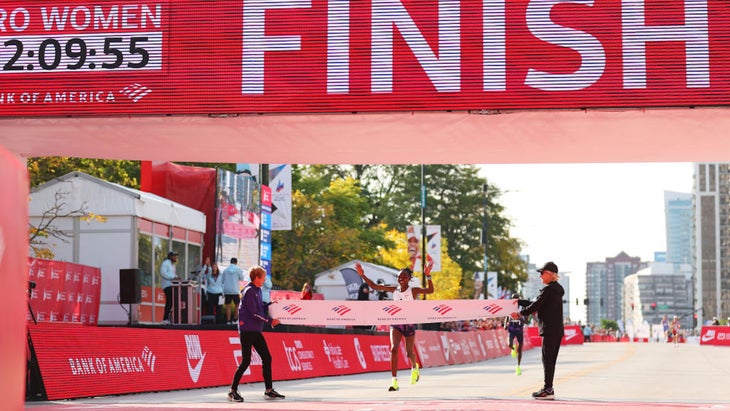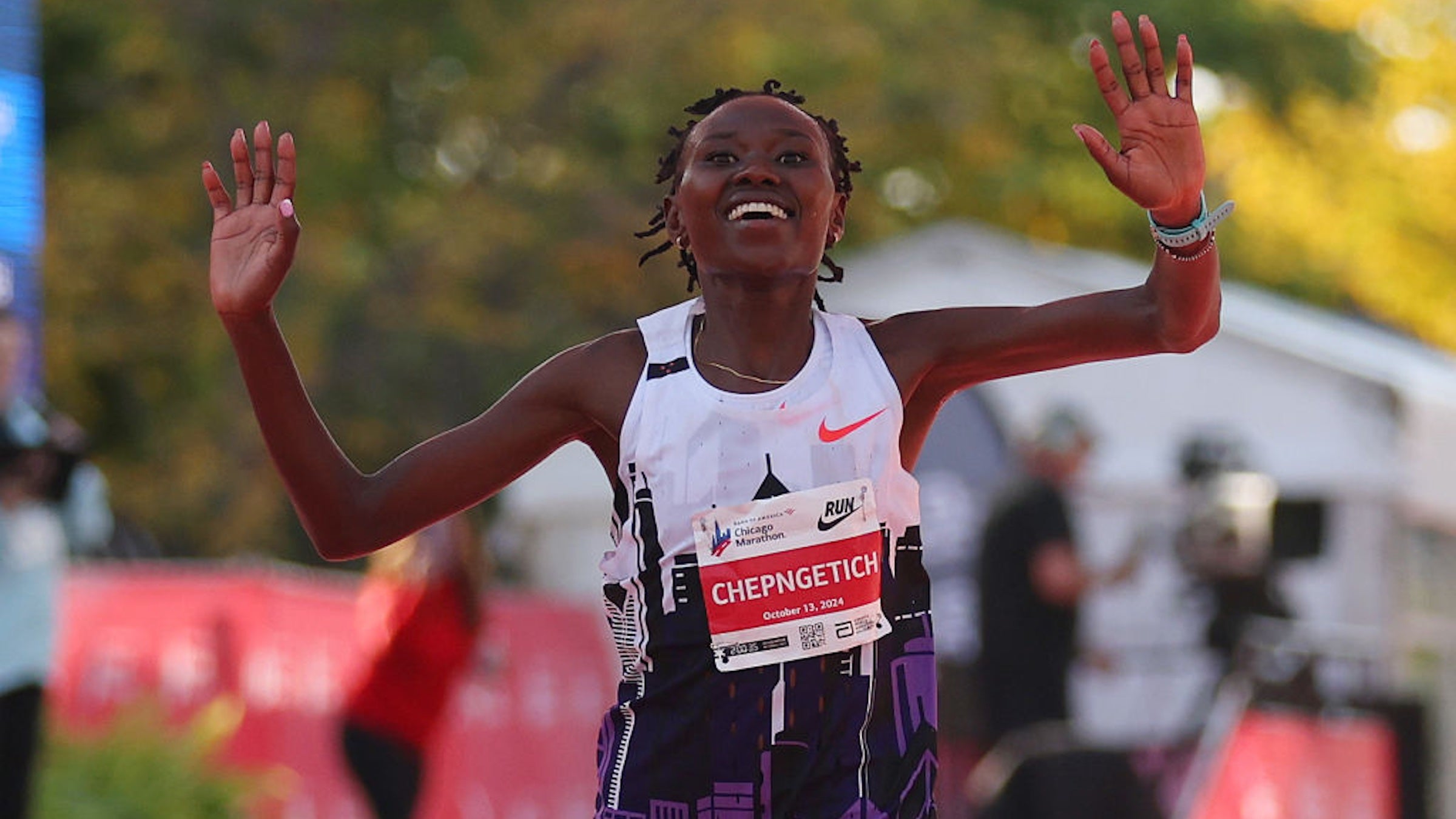To be a sports fan in the modern era is to be at least somewhat numb to the steady drip of doping positives. Occasionally, though, a bust is so big that it changes the trajectory of the sport. Ben Johnson’s positive test in 1988 almost crushed track and field for a decade. The BALCO scandal, which in the early 2000s implicated big names like Marion Jones and Barry Bonds, brought anti-doping to pro sports leagues. Lance Armstrong’s demise coincided with the introduction of the “biological passport,” which many observers believe has helped rein in the most flagrant forms of doping.
Now we have Ruth Chepngetich. The 30-year-old Kenyan demolished the marathon world record last fall in Chicago, her time of 2:09:56 making her the first woman under the 2:10 barrier… and the 2:11 barrier. Only two other women have even broken 2:14. It was a historic, epoch-defining performance—and, as I wrote at the time, so improbable that it prompted a highly unusual storm of skepticism from commentators. Sure enough, the Athletics Integrity Unit that Chepngetich has accepted a two-year suspension after hydrochlorothiazide (HCTZ), a banned diuretic sometimes used to mask the presence of other drugs, was found in her urine.
The question is: What comes next? Will it be business as usual, as has happened in the past after notable busts like 2016 Olympic marathon champion Jemima Sumgong? Will there be a crackdown on doping, perhaps with heightened out-of-competition testing funded by the world’s top marathons, or stiffer penalties for the agents, coaches, and sponsors who work with athletes who test positive? Or will Chepngetich’s shocking-but-not-surprising downfall simply confirm that doping is ubiquitous and unavoidable—and that instead of wringing our hands about it, we should start getting excited about next year’s pro-doping Enhanced Games?

The Case for Business as Usual
There’s one sense in which Chepngetich’s positive test is, well, a positive: it demonstrates that there’s no protection for even the biggest names in the sport. In the past, athletics officials at the very highest echelons of the sport have covered up doping positives for —and taken bribes to do so. Chepngetich’s bust is a disaster for the sport, but it didn’t get suppressed.
She’s not the first big name to go down in recent years—in fact, she’s not even the first marathon world-record holder from Kenya to go down. Wilson Kipsang, who set the men’s record in 2013, was sanctioned in 2020 for a series of missed tests. Middle-distance runner Asbel Kiprop, an Olympic gold medalist like Sumgong, tested positive in 2017. Three-time Boston Marathon champion Rita Jeptoo tested positive in 2014. Clearly the testing regime is working on some level, and no one is immune.
Even for those who might get away with doping, there’s good evidence that they can’t get away with as much. Instead of just trying to catch cheaters in the act with blood or urine tests, the biological passport program takes regular tests from athletes in order to establish their personal normal values. If a test shows sudden deviations from the usual values, the athlete can be banned for doping even in the absence of a positive test for a specific drug. An analysis of performances by Russian women before and after the introduction of the biological passport in track and field in 2012 found that they got two to three percent slower, likely because they could no longer use blood doping with impunity.
Still, you can only push this logic so far. The stream of prominent doping positives means testing is working, but it also means that a lot of athletes are still cheating. It’s also notable that the levels of performance in endurance sports such as cycling and running have been accelerating in recent years. In running, we’ve been able to blame it on supershoes—even though they’ve been around since 2016 while performances have continued to improve. In cycling, a common explanation is super-high levels of carbohydrate during races. But it’s hard not to wonder whether there’s a simpler and more obvious explanation.
The Case for Fighting Back
One of the curious details about Chepngetich’s case is that she tested positive for HCTZ. Endurance athletes typically go down for erythropoietin (EPO), which boosts the number of oxygen-carrying red blood cells in the body, or for biological passport violations related to blood doping, which involves injecting extra blood (either your own or someone else’s) to get more red blood cells. These are fairly simple and widely understood forms of doping—the kind of thing a lone wolf could pull off.
In contrast, HCTZ is a diuretic, which can be used to dilute urine so that other banned substances don’t show up in tests. My usual assumption is that these kinds of masking agents are hiding steroids or other muscle-related drugs. There’s also evidence that diuretics can affect the results of blood tests in the biological passport program, for example . But spoofing the biological passport is a far more complicated game and would suggest a much more sophisticated and systematized doping operation.
Chepngetich voluntarily accepted a provisional two-year suspension in April while the case moves forward, which suggests she’s eager to get the ban over with in order to return to competition. Personally, I would hope any return to competition is contingent on a full and frank disclosure of exactly what she drugs she was taking and who helped her. This is a tricky idea to enforce, but one way or another we need to get a better window into how athletes are cheating.
There are lots of other ways we could use the Chepngetich case as a spur to ramp up the fight against doping—things like making agents responsible when their athletes test positive (it’s notable that Chepngetich’s agent, Federico Rosa, also represented Sumgong, Jeptoo, and Kiprop), or getting the World Marathon Majors group to fund more out-of-competition testing before their races rather than just after the finish. The truth, though, is that these are mostly the same ideas trotted out after every doping scandal.
The Case for Surrendering
Last month, Wired’s Amit Katwala the best account yet of the rise of the Enhanced Games, the drugs-permitted sports event currently slated for next May in Las Vegas. My general take on this saga has mostly been that I prefer to ignore it. Sports, to me, are (as the philosopher Bernard Suits put it) about the voluntary attempt to overcome unnecessary obstacles. Arbitrarily removing some of the obstacles—by moving the start line forward, say, or by taking drugs that we’ve agreed not to take—is simply uninteresting to me.
The problem, of course, is that not everyone agrees to avoid the drugs on the banned list. Allowing athletes to take drugs, as the Enhanced Games plans to do, would eliminate all the effort required to police this rule and return us to an even playing field. I don’t find the idea attractive, but Chepngetich’s positive makes this a good time to ask: Why not?
One of the most interesting threads in Katwala’s article is how the apparent mission of the Enhanced Games has shifted over time. Initially its rallying cry was the libertarian ideal that people should be able to put whatever they want into their bodies. But now it proclaims that all participants will train under medical supervision and be rigorously tested to ensure that participants remain healthy. “Far from throwing off the shackles of the World Anti Doping Agency,” Kitwala points out, “it seemed as if Enhanced had simply re-created it, with a slightly different red line.”
Implicit in this shift is the recognition that unfettered doping would be bad for your health. This is, of course, the fundamental reason that drugs are restricted in sport, but the evidence for this claim isn’t as crystal-clear as you might think. You simply can’t do the kinds of studies that would be required to prove that, say, EPO thickens your blood to the point that you’re more likely to die of a heart attack. EPO has long been suspected as the culprit in among young cyclists after the drug was introduced in the late 1980s, but some researchers view this claim instead as “.”
You can have similar debates about most other performance-enhancing drugs. There’s usually for negative health effects, but the evidence is often indirect or observational. You can make a reasonable case that, for example, testosterone therapy’s benefits outweigh its harms for people starting with low testosterone. As the doses get higher, that case gets harder to make—but figuring out exactly where the line should be drawn is tricky. The key point, though, is that there is a line. Even the Enhanced Games is no longer calling for unlimited doping.
The Verdict
I’ve always thought that one of key but underappreciated distinctions in debates about sports doping is whether you think of athletes as “them” or “us.” Most of the people I’ve argued with who think that doping should be legalized view sport as a spectacle that others take part in. Why not let those people dope to the gills for our greater entertainment, as long as they’re doing it by choice?
To me, though, the question always comes down what I’d feel comfortable doing myself, or letting my kids do. There’s a big gulf between pro marathoners and high-school track, of course—but don’t kid yourself that they’re not connected. If the pros are doing something, then the aspiring pros will have to do it, and so will the college athletes, and so on down the line. “Once an effective technology gets adopted in a sport, it becomes tyrannical,” the ethicist Thomas Murray told me when I was writing about electric brain stimulation a few years ago. “You have to use it.” The same is true of drugs: if we give pro athletes the green light, we’re accepting their use everywhere.
That’s the unspoken truth of doping in sport—but as it turns out, the Enhanced Games is willing to say it out loud. Their real endgame is selling their own line of supplements, inspired by Red Bull’s corporate success. “They buy sporting assets to sell an energy drink,” the event’s founder told Kitwala. “And so our business model is very similar.” They frame this in the language of “human enhancement,” but it basically amounts to “steroids for the people!”
In the end, that’s the argument that convinces me that it’s worth keeping up the fight against doping. I hope that we catch—or better yet, dissuade—future Chepngetiches. I think that sports governing bodies should tweak their rules so that Chepngetich’s sub-2:10 can be erased from the record books even though it took place before her positive test. But I’m mostly at peace with the idea that we’ll never fully win this battle—just as I believe that stealing should remain illegal even though we’ll never eradicate shoplifting. Because if we accept the alternative and decide that doping is OK, it’s no longer just about them; it’s about us.
For more Sweat Science, join me on and , sign up for the , and check out my new book .


